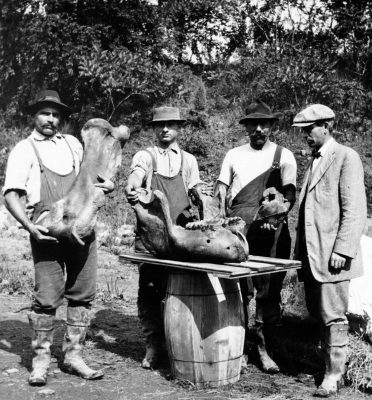The Pope Mastodon

Workmen with their discovery at the Hill-Stead Estate, Farmington in 1913.
FOSA Newsletter Fall 2015
The students are all just back on campus as I write this, so I know that summer is sadly over. It has been a busy Spring/Summer season for OSA and the FOSA support team. I managed to finish the flotation of the many bags of soil from the features excavated last fall at the Dug Road site in Glastonbury. The charred material recovered from the features permitted the identification of plant remains by Tonya Largy. Tonya noted that the most common identifiable plant fragments were from butternut shells. Interestingly, carbonized bark made up between 40% and 95% of the botanical remains examined. Since then, Mike Raber and Marc Banks who have been working on the final site report have completed radiocarbon dating of five feature samples. These range in age from 4230 to 3880 radiocarbon years ago (ca. 2900 – 2300 calBC).
In May, FOSA volunteers helped to excavate around the north and east foundation edges of the Long Society Meeting House in Preston. This National Register site is in need of repair to the rotting sills, and we were able to help lower the surrounding ground surface safely, while avoiding possible impacts to nearby burials. In May and June FOSA members also helped out with a new Kids Dig for Bozrah Middle Schoolers. The community there was very supportive and I am hoping that this turns into another regular outreach program for us.
In June we began our investigation of a possible location of the Windsor Trading Post site with the help of Kevin McBride’s Pequot War Battlefield metal detector specialists. Their survey identified a brass point and a small brass ring, as well as a strike-a-light and lead shot that could also date to the first half of the 17th century. The FOSA Field School continued the investigation of the site through standard Phase II shovel test pit sampling. While we identified possible Middle Woodland activity at the site, no additional traces of the Contact period component were found, suggesting that this was a short-term Native American satellite camp occupied at about the same time that the Windsor Trading Post was in operation.
Working with the Glastonbury Historical Society, we only had two days to investigate the late 17th century Lt. John Hollister lot in South Glastonbury, but FOSA members and other supporters found evidence of a substantial farming complex that consisted of a long “cross passage” style house with three cellars and an additional possible barn and cellar nearby, as well as a number of well features. These incredible results are mostly the work of UConn graduate student Peter Leach’s GPR survey. This is truly one of the most significant sites I’ve had the privilege to work on in the state of Connecticut, and I look forward to working closely with the Glastonbury Historical Society and landowner Mark Packard at the site again next year.
The Connecticut State Museum of Natural History sponsored its own Kids Dig at the Farwell House and Barn site here on campus. Zac Singer and Lori Kessel organized and implemented the excavation with the help of other FOSA volunteers. The Natural History Museum’s Adult Field School took place at two nearby locations in Windsor this year. I have been waiting patiently for about ten years to look for evidence of the Pequot War-era Windsor palisade and finally had my chance. The remnants of the palisade proved elusive to both GPR and standard archaeological testing methods. The stratigraphy documented in the lot investigated along Palisado Avenue indicated that the land surface had unfortunately been significantly altered in the historic period, probably erasing any trace of the palisade trench. A separate GPR survey and excavation within the bounds of John Mason’s lot within the palisade did, however, uncover evidence of an undocumented filled cellar. Long forgotten to local memory, this late 17th to early 18th century house site contained an abundance of domestic artifacts including straight pins, buttons, coins, clay pipe fragments and ceramics, including English slipware, Rhenish and Westerwald German stoneware, porcelain, and English brown and white salt-glazed stoneware.
Finally, I want to especially thank FOSA this year for supporting the radiocarbon date of the Farmington Pope Mastodon (see article in this issue). The date represents very significant new data that helps us reconstruct the late Ice Age landscape of southern New England shortly before humans first arrived here. The Pope mastodon will be returning to an exhibit at the Institute for American Indian Studies this fall. “Old Longtooth” had previously been on display at the Institute between 1977 and 1989, and everyone should take the opportunity to see this old friend again.